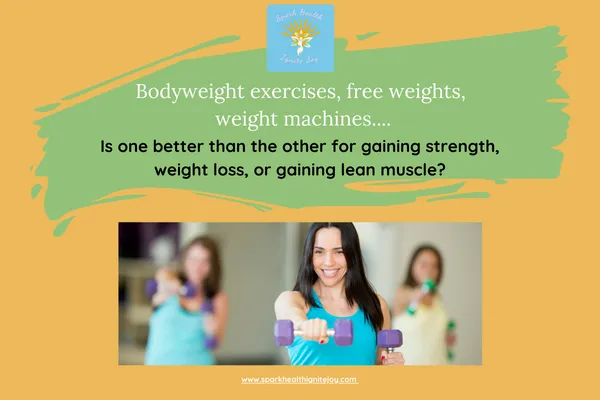Welcome to my Blog!

About the Blogger
Hi, I’m Wendy!
I’m an EXPERT in fun, joy, and living life with a “you gotta put in the hard work for what you want (but still have fun doing it!) and the rewards are SO worth it” mantra for success and getting the most out of life!
I’m a CERTIFIED EXPERT in fitness, nutrition, weight loss and coaching from a habits-based, plant-based perspective that is all about GOOD HEALTH for life.
My passion is helping people truly find and live their optimal lives through making the connections between optimal health and a joyful, fulfilled life.
Though online courses and coaching, I teach strategies for good habits, good health, and being good to yourself and others.

Bodyweight Workouts versus Weight Machine or Free Weights Workouts: is one better than the other?
Maybe you’ve dialed in your nutrition, you’ve been doing your cardio routines, you know that strength training (also called resistance training) is an important part of an overall healthy fitness program but you’re feeling a bit overwhelmed by the various kinds of strength training so don’t know where to start. You’re not sure which kind of resistance training - bodyweight training, free weights or machines - is the best way for you to reach your goals which may include losing weight, improving your body composition so you have less body fat and more lean muscle, or you want to gain muscle. How do you decide which will be the best way to meet your goals for improving your body composition, increasing your strength, gaining lean muscle and losing body fat?
Let’s back up a bit and look more at what strength training is and why you should do it.
The American College of Sports Medicine defines resistance training as “…a form of physical activity that is designed to improve muscular fitness by exercising a muscle or a muscle group against external resistance.”
Resistance training strengthens your muscles by gradually increasing their ability to resist force through the use of free weights, machines, or your own body weight.
Improving your strength is not only effective for overall fitness and weight loss, but most importantly it improves your ability to do the things you do in your daily life, no matter your age. You get stronger and more capable of performing the activities of your activity/sport life and your regular daily life: carrying groceries or children, lifting or moving things around your house, any other physical activities you engage in with more ease. Resistance training has many great benefits!
So - you’re IN for adding strength training to your routine - but now the big questions you might be asking are: do I have to join a gym or have a lot of expensive equipment at home to do my strength training or can I get the same results with at-home workouts? And if I DO join a gym or I have some equipment at home, is it better to use free weights or machines for lifting weights?
Here’s a chart that shows some of the benefits of each type of resistance training:


As you can see from this chart bodyweight training has a number of great benefits! Some of which you don’t get as much from either free weights or machine weight training.
It really depends on your goals. For example, a bodybuilder or power weight lifter will want and need to use weight machines, dumbbells and barbells. Their goal is to build muscle and gain muscle strength while, at least with the bodybuilder, shaping their muscles and body to achieve a certain look. Functional movement improvement or endurance is not a focus.
However for most of us, those two things really benefit us overall in our health and are closer to our goals of losing body fat, strengthening and gaining lean muscle.
For beginners, body weight training is a great way to start. Bodyweight exercises can be convenient, easy to start with, and can potentially build and protect your joints. If you’re just starting out with resistance training, the free weight area at your gym can be intimidating and using free weights or machines without proper technique can lead to injury. Bodyweight exercises can in most cases be performed at home, where you might feel more comfortable if strength training is new to you. You can adapt the exercises to start where you are as a beginner and advance the moves as you progress. For example, if you’re unable to do a full push up on your hands and toes, you can lower your body so your knees are touching the ground instead. Or you can do pushups off of a wall or other sturdy object while on your feet.
However, eventually the limitations of lower-body strength on a bodyweight-only workout regimen make lifting weights — at least for your lower body — still worthwhile. That said, there ARE ways to increase the intensity and effectiveness of bodyweight exercises as you progress. By adding things like static holds as you are doing the exercise you can increase the weight load. Once you have the correct form down, you can incorporate plyometric exercises (dynamic movements which increase your body’s power (strength and speed).
If you’re new to strength training and still need some help with form on your exercises, bodyweight training is much more forgiving and less likely to cause injury than most types of weightlifting. Another advantage to bodyweight exercises are that they are very easy to modify to your ability level whether you are just starting out from a period of inactivity or whether you have progressed further in your fitness. Using bodyweight exercises really helps you develop better body awareness and control which will help you be able to feel your muscles working. This is good for beginners especially as sometimes when beginners start out on weight machines they are not using correct form which means they are not actually isolating and working the correct muscles.
Bodyweight training builds a strong core. Most bodyweight exercises engage your core muscles. Even though you may not be aware of it, performing pushups and even holding a handstand require core strength. With bodyweight training and correct form, you’ll develop very strong abdominal muscles.
Bodyweight training can be made very challenging at whatever fitness level you are at. Just look at the bodies of gymnasts! They pretty much exclusively train with their own bodyweight and their body type is extremely muscular, strong and fit. They are able to perform almost unbelievably explosive movements involving body strength. If you doubt the effectiveness of bodyweight training, tell me how many pull-ups, pushups or walking lunges you can do to failure. Or how long you can hold a plank or a “wall sit” for (squat position, back against wall, hold it). I guarantee you that you can still work on just these two bodyweight exercises and find room to make strength and coordination gains. ;)
The variety of bodyweight training exercises is massive, literally hundreds of different exercises and you can adjust them to make them harder and switch up your routines to work your whole body and never get bored. Bodyweight exercises show results, partially because they involve exercises with compound exercises, ones that use numerous joints and muscles during each exercise movement. Bodyweight training — including things like yoga — also incorporates a lot of balance and functional movement to help with stability and activating smaller muscles. This helps to improve your everyday movement and activities in your life. A main benefit of bodyweight training is joint mobility, something that is very important to have as we age.
With bodyweight exercises you can always improve, progress and push through any exercise plateaus you might reach at any given time. You can see and feel progress and this can help with your motivation to keep going.
When you do bodyweight training, using your own body as a weight, most of your muscles are activated when doing a workout. Even the passive muscles are exerted to some extent, even though only the target muscles are the most active in any given movement.
While there are so many benefits to bodyweight training that make it important to incorporate them into your fitness routine, there are some advantages that free weights or machine weights have too, depending on your goals. Using free weights for your resistance training involves lifting weights that are external to your body, for example, using dumbbells, barbells or kettlebells.
Although there are many hard bodyweight exercises that require no extra equipment (like one-legged “pistol” squats, for example) there’s only so far you can strengthen your lower body before you need to add weight. And even if you’re able to work up to doing 100 pistol squats with each leg, eventually to keep progressing you will need to increase the resistance by adding weight on top of your own bodyweight. For your legs, bodyweight training is great in the beginning and even as you progress a certain amount, but that alone may not be sufficient to build long-term muscle mass for your legs if that is what you are aiming for. On the other hand, weight training alone will not build the same amount of muscle endurance, which is what we want for many of our daily activities and sports.
With bodyweight training exercises, because most of the movements are compound ones, it can be hard to isolate and work on specific muscles. If that is your goal then free weights or machines can help with this as they each tend to target certain muscles. Isolating particular muscles, such as biceps for one example, can help you achieve a desired look as you build your body and you can more easily do this with weight training.
Free weight training allows you to easily measure progress in your strength in that you can clearly see how much weight you are lifting. There is also a large variety of ways you can change up the variety of exercises with free weights. For example there are many ways you can vary doing bicep curls with free weights using different grips, positions etc. Using a machine on the other hand, will usually give you just one way of doing bicep curls, for example. Another advantage of free weights over machines is that you generally use more of your body in stabilizing yourself as you isolate the muscles used in whatever exercise you’re doing. Using your “stabilizer muscles as you perform the exercises helps you build core and other strength. You can also combine movements such as doing a dumbbell squat combined with a bicep curl or lateral raise etc. There are many different combinations you can choose.
If building muscle is one of your goals (a different thing than “toning” your existing muscles or losing body fat), weight training is better than bodyweight training, in most cases, for this. There are different lifting techniques - things like super-sets and drop-sets just for a couple of examples, that you can use to fully stimulate muscles and build muscle mass. Although any weight-bearing exercise will help with this, lifting heavier weights as you progress helps you gain even more bone density and tendon strength. Lifting weights stimulates the production of natural anabolic (muscle-building) hormones like Human Growth Hormone — which changes your body composition and helps you gain lean muscle and lose body fat.
A benefit to using free weights in particular (compared to machines) is that they allow you to target very specific muscle groups to correct any muscle imbalances you may have. For example, if one bicep or part of your back or chest is larger or stronger than the other, you can easily target the weaker one by doing specific exercises on just that one side, doing more repetitions on that side, or using a different amount to weight to build it up etc. Another benefit that free weights have over weight machines is that they tend to exert a wider range of muscles. That’s because you need to incorporate a range of muscles to stabilize your body when working out.
Weight machines, compared to free weights, have the capacity of focusing on specific muscles or muscle groups. This may be useful in helping you rest one group of muscles on alternating days. It will help you to continue working out different muscle groups as you rest the others, without interrupting your daily workout schedule.
Weight machines provide a specific range of motion and restrict your movements. Because of this, they can be great for rehabilitation exercises of a specific body part. The flip side of this is that machines can’t deliver the kind of full-body results you can get with bodyweight or free-weight exercises because they usually isolate one muscle group.
Okay let’s talk about fat loss and bodyweight versus weight training if that is part of your health and fitness goals. When comparing bodyweight vs weights for weight loss, it is important to know consider how each method works in reducing body fat.
Bodyweight exercises enhance the burning of fat DURING the workout. Weight training exercises can up the rate of fat loss long after you finish the workout. This is because of your basal metabolic rate (BMR). Your BMR refers to the pace at which you burn calories for energy even when resting, digesting or sleeping. It is important to know that your BMR rate is influenced by various factors including the amount of lean muscle mass that you have. If you have more lean muscle mass, your daily BMR increases even while resting. Since weight training helps you gain muscle mass, this is why it also helps you lose weight even when you’re not working out. It’s kind of like having lots of money in the bank sitting there gaining interest for you! The higher your BMR is, and you can increase it through resistance training in way you can’t with just doing cardio workouts, the more it is working for you to help you reduce body fat 24 hours a day.
Generally speaking, one hour of bodyweight exercise will burn about from 200 to 400 calories for you depending on the intensity of movements. You CAN however burn more calories with a higher intensity bodyweight workout. However, you can only build muscle mass up to a certain point. So, doing both weight training and bodyweight exercises (particularly in the form of High Intensity Interval Training workouts) is ideal for fat loss.
So - what’s the bottom line? Deciding whether to use bodyweight training, free weights or machines depends on where you are starting from in your health and fitness, and on your goals. Many people use a combination in their workout plans.
If your main goal is to see progress in the actual amount that you can lift, bodyweight training might not be the best choice for you to focus solely on— free weights or machines, with the ability to see how much weight you are lifting might be what you are looking for.
If you’re just starting out and may be intimidated by free weights or machines and don’t have coaching, being able to start out at home makes bodyweight training a fantastic place for you to do resistance training, see progress, and becomes more familiar with and confident in the exercises and your body. Studies have also shown that bodyweight workouts can help beginners develop their strength and endurance faster than using free weights or machines, up to a certain point.
But - know that when it comes to improving your body composition, either method will work. Both methods are training your muscles against resistance, which improves muscle, strength and metabolism — and ultimately fat loss. But if you don’t do any bodyweight training and only use weights your overall movement capacity for daily activities, joint health, and athleticism may be limited.
Fitness Spark!: As you can see by the benefits (and some disadvantages) of both methods of resistance training, a workout plan that incorporates both gives you the best of both worlds! If your goal is to improve health, be generally athletic, and feel good about the way you look and move, then use a combination of weight training and bodyweight training!

Sign up for my newsletter here for nutrition, health, wellness and fitness tips to help you Spark Health, Ignite Joy!



Facebook
Instagram
X
LinkedIn
Pinterest